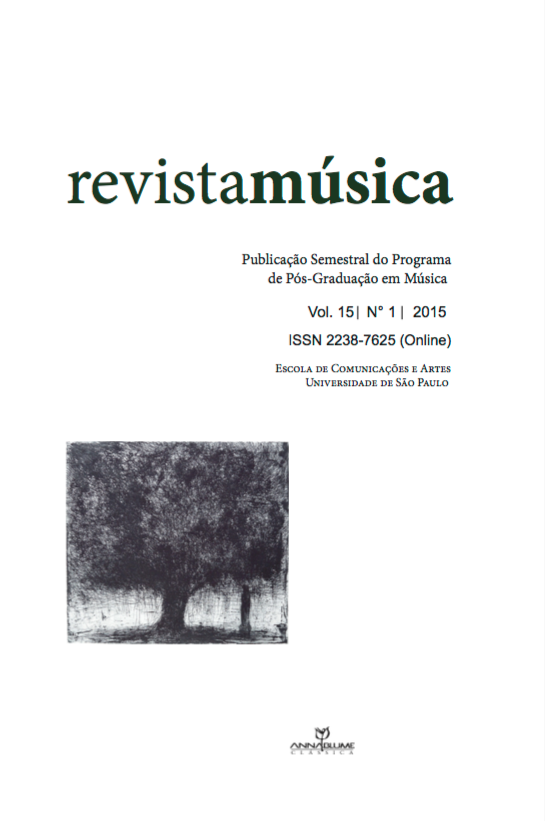Fabritio Caroso’s Balletti: “The dancer’s own language?”
DOI:
https://doi.org/10.11606/rm.v15i1.114701Palavras-chave:
Renaissance Dance, Rhetoric, Fabritio Caroso, BallettiResumo
In the 16th Century, ladies and gentlemen of noble birth were taught from an early age the art of dancing, necessary to survive in the hierarchical world of the court. A Neo-Platonic perspective on dancing was at the core of Renaissance thinking (Humanism) and persisted throughout the 17th Century. In dance circles the principles of harmony and order in the cosmos, harking back to the classical world of Plato and Quintilian, were already well established in Italy by the end of the 15th Century. The balli were structures consisting of many different rhythmic sections throughout which a playful narrative of love, courtship and drama unfolded. By the second half of the 16th Century, two notable dancing masters, Fabritio Caroso and Cesare Negri, were beginning to record their teaching and advice in manuals, which serve as the first known comprehensive and detailed treatises on court dance. By the late 16th Century, the balletto still involved the theatricality of narrative and contrasting or varying emotions. It was still a performance or game for the spectators as well as for the dancers themselves, despite being performed in a social context. In this article, we take a closer look at two balli presented by Caroso: Ardente Sole and Laura Soave, showing that their structure was inspired by rhetorical principles.
Downloads
Referências
ARBEAU, Thoinot. Orchesography (Langres1589). New York: Dover, 1967. Translated by Mary Stewart Evans.
CICERO, Marcus Tullius. Cicero on the Ideal Orator [Orator, I a,C.]. New York: Oxford University Press, 2001. Translated by James M May and Jakob Wisse.
CAROSO, Marco Fabrizio. Il Ballarino (1581). New York: Broude Brothers Ltd., 1967. Facsimile.
CAROSO, Marco Fabrizio. Nobilita di Dame. Bologna: Forni, 1980. Facsimile.
CAROSO, Marco Fabrizio. Courtly Dance of the Renaissance, a New Translation and Edition of the Nobilta di Dame (1600). New York: Dover, 1995. Translated by Julia Sutton
CASTIGLIONE, Baldassare. The Book of the Courtier (Il Libro del Cortegiano, 1528). London: Penguin, 1978. Translated by George Bull
CORNAZANO, Antonio. The Book on The Art of Dancing (Libro dell’ arte del danzare, 1455). London: Dance Books Ltd, 1981. Translated by Madeleine Inglehearne & Peggy Forsyth.
DALLA CASA, Giovanni. The Perfect Gentleman (London, c 1576; translated from Galateo, 1555). In: ROSS, James Bruce; MC LAUGHLIN, Mary Martin. The Portable Renaissance Reader. London: Penguin, 1977. Translated by Robert Peterson, 1576
DAVIES John. Orchestra or a Poem of Dancing (c1594). London: Chatto & Windus, 1947
FRANKO, Mark. Writing Dancing 1573. In: DILS, Ann. Moving History/Dancing Cultures: a dance history reader. Middletown: Wesleyan University Press 2001, p. 191-201
NEGRI, Cesare. Le Gratie d’Amore (Milano, 1602). New York: Broude Brothers Ltd, 1969. Facsimile.
NEVILE, Jennifer. The Eloquent Body: Dance and Humanist Culture in Fifteenth Century Italy’. Michigan: Indiana University Press, 2004
PLAYFORD, John. The English Dancing Master. London, 1651
QUINTILIANUS, M. Fabius, Institutio oratoria. London: Heinemann (Loeb Classical Library), 1922. Translated by H. E. Butler
FURTHER REFERENCES
SLILES Howard, The Politics of Courtly Dancing in Early Modern England. Amhurst: University of Massachusetts Press, 1988
BALDWIN, Charles Sears. Ancient Rhetoric & Poetic. Westport: Greenwood Press, 1924
WARD, John O. From Antiquity to the Renaissance: Glosses and Commentaries on Cicero’s Rhetorica in Medieval Eloquence. In: MURPHY, James. Studies in the Theory and Practice of Medieval Rhetoric. Berkeley: University of California Press, 1978.
Mc. GINNIS, Katherine Tucker. Your Most Humble Servant, Cesare Negri Milanese. In: NEVILE, Jennifer. Dance, Spectacle, and the Body Politick, 1250-1750. Michigan: Indiana University Press, 2008, p. 211-228
Mc GOWAN, Margaret. Dance in the Renaissance: European Fashion, French Obsession. New Haven and London: Yale University Press, 2008
NEVILE, Jennifer. Order, Proportion, and Geometric Forms: The Cosmic Structure of Dance, Grand Gardens, and Architecture during the Renaissance. In: NEVILE, Jennifer. Dance, Spectacle, and the Body Politick, 1250-1750. Michigan: Indiana University Press, 2008, p. 295-312
PONT, Graham. Plato´s Philosophy on Dance. In: NEVILE, Jennifer. Dance, Spectacle, and the Body Politick, 1250-1750. Michigan: Indiana University Press, 2008, p. 267-282
Downloads
Publicado
Edição
Seção
Licença
Copyright (c) 2015 Mary Collins

Este trabalho está licenciado sob uma licença Creative Commons Attribution-NonCommercial-ShareAlike 4.0 International License.
Autores que publicam nesta revista concordam com os seguintes termos:
- Autores mantém os direitos autorais e concedem à revista o direito de primeira publicação, com o trabalho simultaneamente licenciado sob a CC Attribution-NonCommercial-ShareAlike 4.0 que permite o compartilhamento do trabalho com reconhecimento da autoria e publicação inicial nesta revista.
- Autores têm autorização para assumir contratos adicionais separadamente, para distribuição não-exclusiva da versão do trabalho publicada nesta revista (ex.: publicar em repositório institucional ou como capítulo de livro), com reconhecimento de autoria e publicação inicial nesta revista.
- Autores têm permissão e são estimulados a publicar e distribuir seu trabalho online (ex.: em repositórios institucionais ou na sua página pessoal) a qualquer ponto antes ou durante o processo editorial, já que isso pode gerar alterações produtivas, bem como aumentar o impacto e a citação do trabalho publicado (Veja O Efeito do Acesso Livre).


